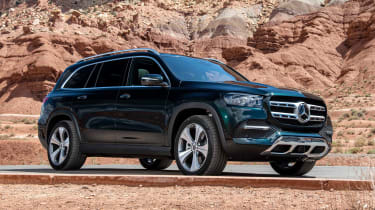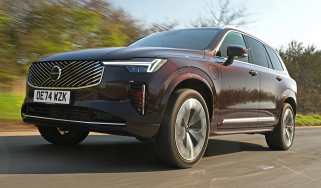Mercedes GLS SUV
"The Mercedes GLS represents the ultimate in space and luxury for SUV buyers"
Pros
- Luxurious
- Spacious
- Laden with tech
Cons
- Feels enormous
- Huge price difference between models
- Expensive to run
Verdict - Is the Mercedes GLS a good car?
The latest Mercedes GLS is the brand’s flagship seven-seat SUV. It's incredibly refined and comfortable, offering a limo-like experience, and its enormous size results in the best, most luxurious third-row of any SUV. However, this king of the road looks like a bit of a relic compared to the all-electric Mercedes EQS SUV. With either a large diesel or V8 petrol engine, the GLS is thirsty and expensive to run.
Mercedes GLS models, specs and alternatives
The GLS will certainly make the decision more difficult for anyone weighing up a Range Rover, Audi Q7, Volvo XC90 or BMW X7, while the flagship AMG model rivals the opulent Bentley Bentayga. Buyers could be swayed by the Mercedes-Maybach version of the GLS with E-Active Body Control; this clever technology sees the air suspension take on a life of its own. Not only does it react to the road's surface but it can also lean the GLS into corners like a roller coaster, help get it unstuck off-road and use cameras to identify bumps in the road ahead and adjust the suspension to better absorb them.
 Best luxury SUVs to buy in 2025
Best luxury SUVs to buy in 2025
With it fitted, the GLS lives up to its "S-Class of SUVs" billing, transporting passengers in serene comfort. There are six- or seven-seat layouts available, with three rows of two seats or a three-person middle bench. Choose the latter and an optional pack sees the middle seat fold down to create a large armrest, complete with a tablet. Buyers can also specify rear entertainment screens and massaging seats.
More reviews
In-depth reviews
They may, however, want to wait for the 2023 facelift to arrive before taking the plunge. Along with refreshed exterior styling, there are new alloy wheel designs – but the biggest changes come inside. Here, the latest tech from the Mercedes S-Class and EQS has been added, with greater customisation for the MBUX driver and infotainment displays.
Luxury might come first but you could also use the GLS as a posh workhorse, thanks to its enormous boot space and 3,500kg towing capacity. All the seats fold at the push of a button and even with seven occupants there's still 470-litres of luggage space - more than most family hatchbacks offer.
Most buyers will choose the GLS 400 d with its 3.0-litre V6 diesel, offering 325bhp, four-wheel drive and a nine-speed automatic gearbox. Despite the GLS' size, it gets from 0-62mph in 6.3 seconds, so never feels lacking in power. A relaxed driving style suits the GLS best, and while the BMW X7 with four-wheel-steering feels more agile, the Mercedes is reassuringly stable.
The Mercedes-AMG GLS 63 was added to the line-up in early 2020, and it packs a meteoric 604bhp, making it more powerful than the Range Rover SVR, and not far behind the 641bhp Lamborghini Urus. It’s over two seconds quicker to 62mph than the diesel, and features an array of exclusive styling details – not to mention expensive running costs, with fuel economy of around 22mpg.
MPG, running costs & CO2
Besides the hugely powerful flagship AMG model, only one engine is offered in the GLS, putting it at somewhat of a disadvantage to rivals with various diesel and plug-in hybrid (PHEV) power options. A PHEV could join the range later; the Mercedes GLE – the smaller SUV which it shares many parts with – is offered with a diesel-electric GLE 350 de version.
The diesel GLS 400 d 4MATIC can return up to 32.1mpg, which is reasonable for a vast SUV with a potent engine but nothing to write home about. Meanwhile, CO2 emissions of 229g/km place the GLS firmly into the top tier for BiK banding, making it a pricey proposition for company-car drivers. A Volvo XC90 T8 Recharge plug-in hybrid should prove much cheaper to run, qualifying for a mid-range BiK band. Other German rivals also offer better fuel economy, with the diesel Audi Q7 and BMW X7 managing up to 35.8mpg and 36.2mpg respectively.
As you might expect, the running costs for the powerful AMG model are even steeper, with careful driving likely to get you fuel economy of around 22mpg at best. CO2 emissions are also equally high, with the GLS 63 emitting 291g/km, a figure that’s close to some supercars. The 4.0-litre V8 engine is only happy with costlier super-unleaded fuel, but we can’t imagine too many owners will be overly concerned. The Mercedes-Maybach GLS 600 emits over 300g/km and returns 21mpg, making it even more rarefied.
Annual road tax will cost the standard rate, but its list price above £40,000 incurs a surcharge in the first five renewal years, bringing the total to over £500. Insurance is also likely to be expensive, with the GLS 400 d starting in group 48 out of 50, and other versions in the top group.
Engines, drive & performance
The GLS 400 d is fitted with Mercedes' familiar 3.0-litre V6 diesel, serving up a sizeable 325bhp and 700Nm of torque. This means that despite the flagship SUV weighing two-and-a-half tonnes, it still has the brute force to get from 0-62mph in 6.3 seconds and on to an impressive 148mph top speed. With so much pulling power arriving early in the rev range, it's an engine that suits the car.
If you want a more powerful engine, the thundering Mercedes-AMG GLS 63 uses a twin-turbocharged 4.0-litre V8 petrol unit. With 604bhp at your disposal, this seven-seat behemoth can hit 0-62mph in just 4.2 seconds going on to a limited top speed of 155mph. The standard AMG GLS 63 isn’t even the range-topper though – the Night Edition Executive pack removes the speed limiter, so you can hit 174mph on the German Autobahn.
If your budget will stretch, it’s worth considering the Mercedes-Maybach GLS 600 for its E-Active Body Control suspension. With it fitted, the car adapts to suit the road conditions. It possesses some remarkable talents; adjusting the ride height of each wheel independently off-road, and leaning the GLS into corners like a high-speed train thanks to its 'Curve' mode. This works well on motorways and fast roads but it can't always keep up on twistier B-roads.
Rivals like the BMW X7 are more engaging but the GLS feels stable no matter the conditions. It could do with the four-wheel-steering of the BMW, though, because the GLS feels less manoeuvrable at lower speeds.
Interior & comfort
Mercedes describes the GLS as the S-Class of SUVs, and E-Active Body Control plays a big part here because it transforms the ride quality – it’s a shame it isn’t offered lower in the range. Using forward-facing cameras and adaptive air suspension, it identifies upcoming bumps and potholes and adjusts the suspension to soak them up. The result is uncanny, getting rid of the occasional thumps and side-to-side rocking motion noticeable with the standard setup.
Based on the same underpinnings as the Mercedes GLE, the GLS also shares its dashboard setup with twin 12.3-inch screens making up its instrument panel and infotainment display. Called 'MBUX', this is one of the best technology suites available in a car but some prospective customers may long for a more unique interior than the more run-of-the-mill and less expensive GLE. The facelifted version arriving in 2023 should deliver on this, with an increase in technology to bring the flagship SUV up to scratch with the Mercedes S-Class and all-electric EQS SUV.
A major strength of the GLS is in the back two rows. Here is where the GLE's huge size really pays off and the comparison with the S-Class makes the most sense. Buyers can choose either a six- or seven-seat layout, with the former fitted with two individual seats in the middle row. Stick with seven seats and an optional Rear Comfort Package Plus means the centre backrest can be folded down to create a large armrest with a removable tablet. There's also the option of 11.6-inch touchscreens mounted in the backs of the front seats to keep passengers entertained.
There are two versions of the regular GLS available called Night Edition and Night Edition Executive. As you might expect, both are loaded with kit, including 22-inch alloy wheels, keyless entry, a 360-degree camera, Parking Pilot, air suspension, a DAB stereo and head-up display – to mention just the highlights. Night Edition Executive adds an even more luxurious interior – particularly for those sitting in the back – where there are heated cup-holders and wireless smartphone chargers align with a removable MBUX seven-inch tablet device. The cabin also features a Nappa leather dashboard and door trims, a black microfibre roof liner, plus climate controlled massaging seats.
The AMG versions get unique styling upgrades, giant 23-inch alloy wheels, Nappa leather as standard and exclusive interior bits like an AMG steering wheel. It’s also hardly pared back, with most of the convenience and luxury features from the regular trims still included.
Practicality & boot space
Measuring over 5.2 metres in length, the Mercedes GLS is one of the biggest cars on sale in the UK, and this translates to enormous interior space. In fact, Mercedes says the third row is suitable for passengers of up to six feet four inches tall, not just the kids and small adults normally able to fit in an SUV's third row.
Even with all seven seats in use, the boot still measures a usable 355 litres, which beats the still-impressive 326 litres in the BMW X7. With five seats in place, there's an 890-litre boot and with all the rear seats electrically folded down this increases to a massive 2,400 litres, making it almost identical to the Land Rover Discovery.
If you have a seriously large caravan or perhaps a boat, or even another car to tow, the GLS is also perfectly suited thanks to its 3,500kg capacity. However, it’s worth noting, this drops slightly to 3,300kg for the GLS 63.
Reliability & safety
The Mercedes GLS appears to be an exquisitely crafted car, with little expense spared in its construction, but owners responding to our 2022 Driver Power survey weren't especially positive about the Mercedes brand as a whole. It only came 23rd out of 29 manufacturers, with 27.3% of owners telling us they experienced one or more faults within the first 12 months, with electrics and interior trim problems the most common. More general niggles included hefty servicing, road tax and insurance bills, which are all areas where the GLS falls down. Ride comfort isn’t likely to be a big issue in this SUV though, thanks to its standard-fit air suspension.
Safety is less likely to be a concern; Mercedes has had a string of five-star Euro NCAP crash-test results in recent years and fits some of the most advanced safety technology available for any car. As standard, the GLS comes with an active bonnet to help protect pedestrians in an impact, a multitude of airbags and a system to warn the driver if they show signs of drowsiness. Autonomous emergency braking, blind-spot warnings and active lane keeping are all standard.
Which Is Best?
Cheapest
- NameGLS 450d 4Matic AMG Line Premium + 5dr 9G-Tronic
- Gearbox typeSemi-auto
- RRP£109,730
Most Economical
- NameGLS 450d 4Matic AMG Line Premium + 5dr 9G-Tronic
- Gearbox typeSemi-auto
- RRP£109,730
Fastest
- NameMaybach GLS 600 4Matic 5dr 9G-Tronic
- Gearbox typeSemi-auto
- RRP£180,785






























